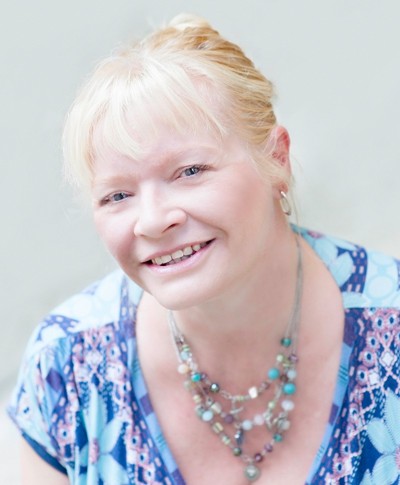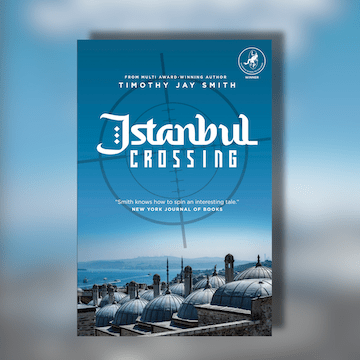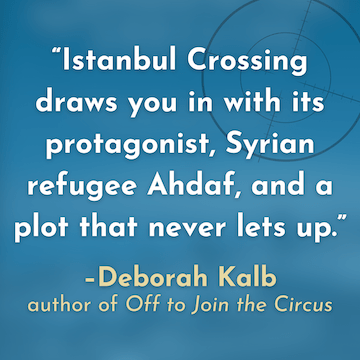
The old motto ‘if at first you don’t succeed, try, try again’ could have been written for Karen Charlton. The former teacher from North East England has become a full-time historical crime writer. On her way to success, she’s seen many ups and downs.
Her new book, The Sans Pareil Mystery, is just out, published by Amazon’s Thomas and Mercer. Ahead of its launch, Karen found time to answer a few Crime Fiction Lover questions…
When did you start writing?
I’ve always been a scribbler. In fact, when I was eight years old I announced to my family that I intended to be a full-time writer when I grew up, just like Enid Blyton. They were a bit startled by this and advised me to get a proper job first, which I did. I served a long stretch as one of Her Majesty’s secondary school teachers.
But back in 2004 there was an event which changed my life. My late husband and I shared an interest in genealogy and that summer we discovered that he had a jailbird sitting in his family tree. Jamie Charlton was transported to Australia for stealing £1057 from Kirkley Hall in Northumberland in 1810. His conviction was dodgy even by the harsh standards of the Regency justice system and an outcry ensued in Newcastle following the trial. The more we uncovered about this miscarriage of justice, the more convinced I became that the perfect plot for a historical novel had just landed in my lap. I began writing Catching the Eagle in January 2009. At the time I was still teaching full-time and I had two small children. It took 20 months to write the novel and another six months to find a traditional publisher.
What drew you to historical crime fiction?
I have always loved historical fiction and was a great fan of Winston Graham’s Poldark novels, Georgette Heyer and the 19th century classics. But I don’t suppose I would have ever dabbled in the genre if it hadn’t been for Jamie Charlton.
Interestingly enough, in another, far earlier, life I spent several years writing Murder Mystery weekends for a at a luxury hotel in North Yorkshire. We even won a Tourist Board award for them. This unusual experience probably sowed some seeds for my future career as a crime writer, although I wasn’t aware of it at the time.
Could you ever see yourself writing a novel in a contemporary setting?
Not at the moment. I love immersing myself in the world of Regency England. There is something very attractive about this time period with its white muslin dresses, highwaymen, dashing scarlet uniforms and that intriguing whiff of decadence and scandal. Mind you, the main whiff my two police officers come across is the one emanating from the sewers of the slums in the Rookery of Saint Giles as they track down their suspects. My guys operate mainly in the seedy underbelly of the Capital – apart from when they get called out into the provinces to investigate a case, of course.
How did you come across Detective Lavender and what drew you to him?
Stephen Lavender was a real-life Principal Officer with the Bow Street Magistrates Court and Police Office in London. Following the formation of the police force by Sir Robert Peel in 1821, Lavender became the highly-respected Deputy Chief Constable of Manchester until 1833.
I first came across him when researching my first novel, Catching the Eagle. Wealthy landowning individual citizens – like Nathanial Ogle of Kirkley Hall – could request the help of the Principal Officers in a difficult case. Bow Street would charge them and the officers would claim lucrative expenses on top of their salaries. Nathanial Ogle requested help in solving the mystery of the Kirkley Hall Robbery. Ultimately, Stephen Lavender was the man who put our ancestor in the dock but I don’t hold this against him. In fact, when creating his character for Catching the Eagle I began to like the serious, intelligent and slightly melancholic Detective Stephen Lavender. I also grew very fond of his fictional sidekick, Constable Woods.
By the time I had finished writing the book, I knew that I didn’t want to let either of these guys go, and by then the first seeds of a plot for a new whodunnit had begun to germinate in my head. I sat down at the computer and The Heiress of Linn Hagh was born.
You’ve seen the publishing game from a variety of perspectives – can you tell us about your journey?
My relationship with my first, small traditional publisher only lasted two years. I became increasingly dissatisfied with many aspects of how they worked and when I was offered the chance to regain the publishing rights for my first two novels I jumped at it. After this bad experience, I was loathe to sign with another small publisher so I decided to try self-publishing, starting with The Heiress of Linn Hagh. I organised editing, proofreading and a book cover and thoroughly enjoyed the freedom self-publishing gave me. I self-published Heiress in February of 2014. For the first two months, I made a handful of sales.
Then, in April, the eBook sales in the USA suddenly started to take off. This happened while I was away on holiday in Turkey and I’m still not sure what the catalyst was which kick-started my sales but I was delighted. Suddenly the novel was ranked in the Historical Mystery category in Amazon.com. It was visible to a whole new readership and I was determined to keep it in those charts. I lowered the price for a while to make it more attractive to readers and entered it into several promotions.
To my delight, dozens of new and positive reviews also began to appear. It seemed that the Americans couldn’t get enough of my Regency mystery set in rural Northumberland. After such a slow, frustrating and disappointing start with my previous publisher, this book was finally being read and enjoyed.
The Heiress of Linn Hagh remained in the top 30 Historical Mysteries in America throughout the summer – sometimes reaching the top 20. On one hot, giddy day in August, I sold 130 eBooks – or should I say hot, giddy night? Because of the time difference between the UK and the US, most of my sales were at night. I would go to bed and when I checked my sales first thing in the morning, I would find myself hundreds of dollars richer. It’s definitely the best way for a woman to earn money while lying on her back. I earned more money that August than I had ever done in teaching.
What did you do next?
Conscious that my reviewers were asking for more stories, I quickly set about publishing Catching the Eagle and my short stories. I also began writing the second novel in the Detective Lavender Mysteries: The Sans Pareil Mystery.
But no-one sells that many copies of an eBook on Amazon without attracting attention. In October I was head-hunted by Emilie Marneur, the Senior Acquisitions Editor, from Amazon Publishing. She wanted my Detective Lavender Series to publish under their Thomas & Mercer crime fiction imprint. She had read The Heiress of Linn Hagh and loved it. She wanted to know if there was any chance we could work together on the Detective Lavender Series. After some discussion, she offered me a jaw-dropping advance in order to take over both The Heiress of Linn Hagh and The Sans Pareil Mystery. I know that it was jaw-dropping because my mouth couldn’t formulate words properly when I phoned my sister immediately afterwards.
Despite my reservations about traditional publishers, I have never regretted the decision to sign with Amazon Publishing which has done an amazing job publishing and marketing my books.
Where do you find your ideas?
Some of the smaller incidents in my novels are rooted in unusual things that have happened to me in real life or which I have stumbled across on TV or through reading. Even a chance comment by a friend in the pub can sometimes throw up an idea which can be developed. Obviously the historical context also plays a huge part in shaping and forming my books. For example, the threat posed by the Peninsula War against the French is a significant part of the background to The Sans Pareil Mystery.
It takes time for these disjointed, half-formed strands and ideas to make a whole and I spend a lot time thinking about them during lengthy walks on the beach or during long soaks in the bath. It can be months after the last novel has finished before I know exactly where I’m going with the next. But when that moment does come, it comes fast. Suddenly my brain clicks into a higher gear and with amazing clarity it shapes a myriad random thoughts into the outline of a full-length novel. This is my Eureka! moment – and I have had one with every book.
Do you think that writing about real life characters is a blessing or a curse?
It is always a challenge to bring real historical characters alive in a novel but I thoroughly enjoy doing the research and imagining how these people might have behaved, talked and thought. So I would say that it is a blessing,
Do you already have the plot for the next Detective Lavender book?
I am currently half-way through the third Detective Lavender novel which has a working title, The Sculthorpe Mystery. This is loosely based on a case solved by the real Stephen Lavender back in 1818 for which he was lauded and generously rewarded by the Northamptonshire Magistrates. I have found numerous references to this particular crime in the newspapers, including The Times. They extensively reported the salacious details of the vicious attack on poor William Sculthorpe, but didn’t report how Lavender solved the case so I have plenty of scope for using my own imagination with this novel. I am thoroughly enjoying writing it.
How do you write? Do you set yourself daily word counts, or plan ahead?
I am not a particularly disciplined writer and can spend hours going off on a tangent, researching extra detail, but when I start the writing process I set myself a target of 20,000 words a months. I generally find this do-able.
What advice would you give to any would-be author?
Understand that it’s a craft. That with practice you’re writing will get better, the words will come faster, but be willing to throw away a lot of what you write, especially at the beginning. Learn to take criticism. Find a focus group to read your drafts. Oh, and find a good publisher you can trust. If you can’t find a good publisher you can trust, embrace self-publishing – you never know where it can lead.
What’s next for you?
I have a loose outline in my head for another two Detective Lavender Mysteries after I have finished The Sculthorpe Mystery, so I think I am going to be very busy for the foreseeable future!
We reviewed The Heiress of Linn Hagh under the title The Missing Heiress in 2012, and we reviewed The Sans Pareil Mystery earlier this week.









